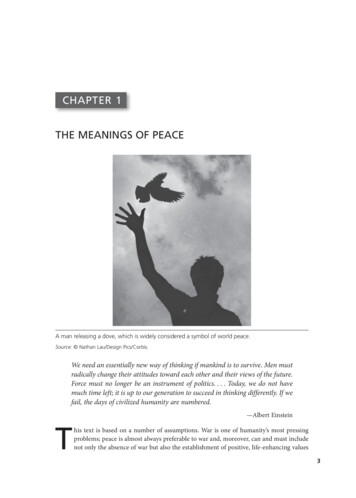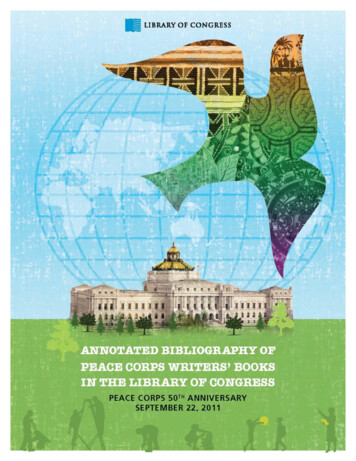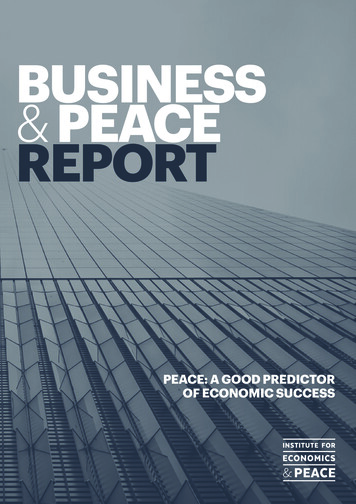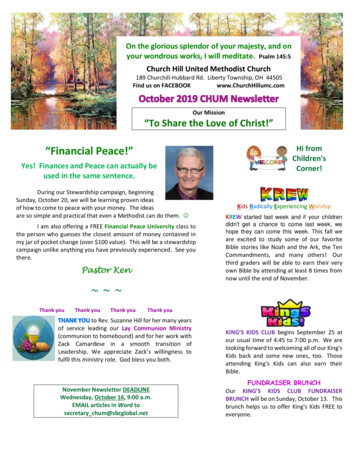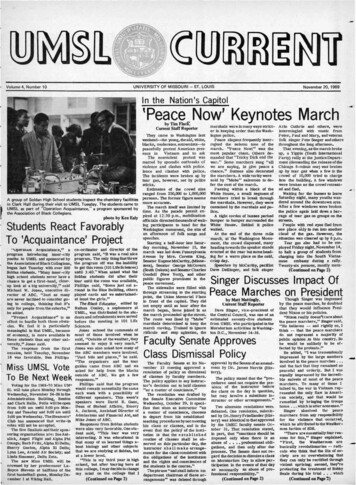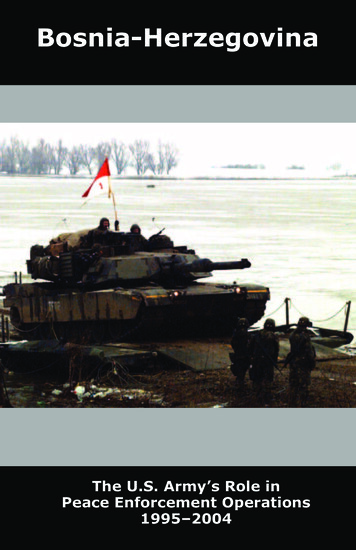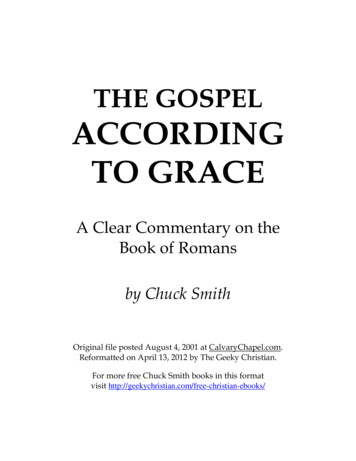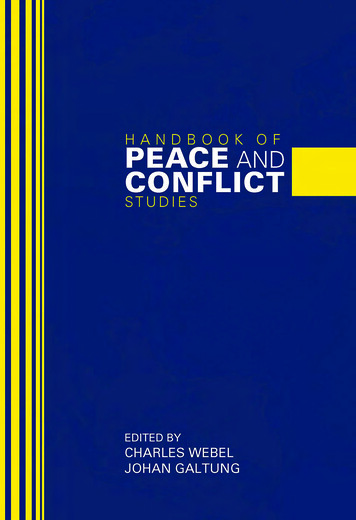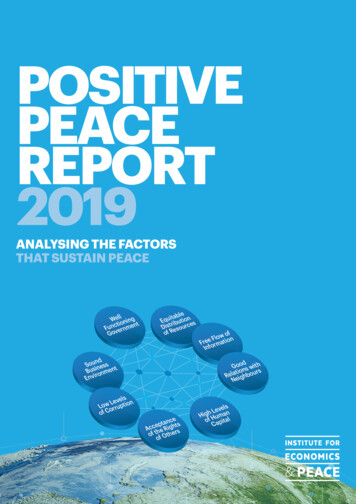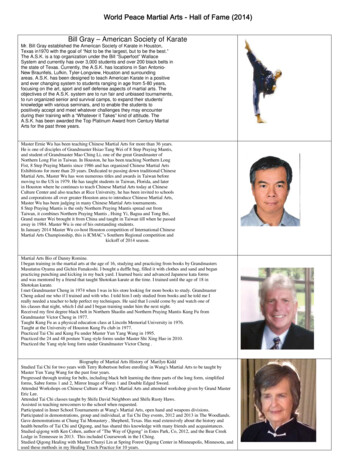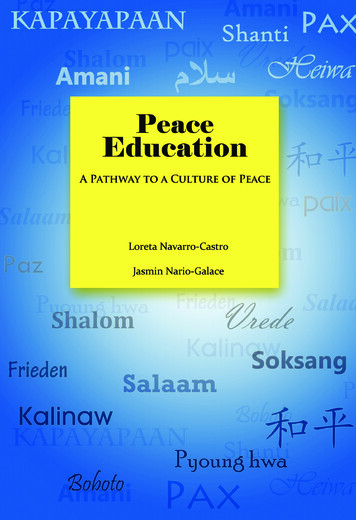
Transcription
Peace Education
Published in 2008 by the Center for Peace Education,Miriam College, Quezon City, PhilippinesWith support from:Samuel Rubin FoundationThe reproduction of this book or any part of it is permitted provided due acknowledgementis given to the Center for Peace Education.Inquiries regarding orders should be addressed to the Center for Peace Education, MiriamCollege, Quezon City, Philippines by using this email address: cpe@mc.edu.ph.Book design by Nikki Al Ben Delfin
Peace Education:A Pathway to a Culture of PeaceLoreta Navarro-CastroJasmin Nario-GalaceCenter for Peace Education, Miriam CollegeQuezon City, Philippines2008
Table of ContentsForeword by Cora WeissvIntroduction by Ambassador Anwarul ChowdhuryviiA Note from the AuthorsxiPart I Toward a Holistic Understanding of Peace and Peace EducationChapter 1A Holistic Understanding of Peace and ViolenceChapter 2Peace Education as Transformative EducationChapter 3The Comprehensive Scope of Peace EducationChapter 4Faith and Spiritual Traditions as Resources for Peace13213139Part II Key Peace Education ThemesChapter 5Upholding Human DignityChapter 6Challenging Prejudice and Building ToleranceChapter 7Promoting NonviolenceChapter 8Challenging the War SystemChapter 9Resolving and Transforming ConflictChapter 10 Sharing the Earth’s ResourcesChapter 11 Caring for the EarthChapter 12 Cultivating Inner Peace49677789101115125133Part III The Peaceable Classroom, Teacher and SchoolChapter 13 Creating a Peaceable Classroom137Chapter 14 Teaching-Learning Approaches and Strategies in PeaceEducation143Chapter 15 Attributes of a Peace Educator151Chapter 16 A Whole School Approach155Conclusion: A Vision for the Future161References163About the Authors173
ForewordWhat a welcome contribution to the growing and urgent field of peaceeducation! Peace does not come with our DNA. To reach peace we need to teachpeace, a phrase well penned by our mentor, Prof. Betty Reardon. People usually say,how wonderful, when you tell them you are in the field of peace education, but Idoubt they know what it really means. At the Global Campaign for Peace Education,which was born at the Hague Appeal for Peace conference in May 1999, we agreedon the following definition: Peace Education is teaching for and about human rights,gender equality, disarmament, social and economic justice, non-violence, sustainabledevelopment, international law and we later added, traditional peace practices. Andwe agreed that the methodology of peace education should include critical thinking,reflection and participation; they are elements that should be integrated into thepedagogy of all teaching at all levels of education.This latest addition to the practical literature of peace education helps theeducator, whether in formal or non formal settings, to understand that peace is aholistic concept and state of being and that it can not be learned in the traditionallecture-note taking-testing framework. Indeed, peace education can be integrated intomany disciplines. The culture of peace must replace the culture of violence if we andour home, planet Earth, are to survive. Tolerance for violence has increased beyondtolerable levels.It was our fervent hope that the most violent of all centuries, the 20th, would,because people were tired of war, and angry that precious resources were being takenfrom human security needs, transform into a non violent 21st century. It is hardto imagine that two major wars opened this new century- wreaking havoc, death,destruction, torture, rape, and trauma- to combatants and civilians, and permanentenvironmental damage to the land, sea and air.The world can not afford war. People can not stand by while the numbersof war and environmental refugees soar, while poverty spreads like an epidemic, andmoney for education, health, job training and other needed services are stolen to pay
vifor weapons.Only when ministries of education realize that their responsibility includespreparing future generations to not only know how to read and write, but also to bethoughtful, responsible members of their communities, who will graduate not to makemoney but to make a difference, will we rest knowing that we have contributed tocreating a Culture of Peace.Thank you, Loreta and Jasmin, for helping to make that happen. And thank youfor contributing this wonderful volume to the Global Campaign for Peace Education.It will be available on www.(world without war) haguepeace.org.CORA WEISSPresident, Hague Appeal for PeaceFormer President, International Peace Bureau
viiIntroductionHumankind needs to take lessons from its past in order to build a new and bettertomorrow. One lesson learned is that, to prevent our violence-ridden history repeatingitself, the values of peace, non-violence, tolerance, human rights and democracy willhave to be inculcated in every woman and man – young and old, children and adultsalike.No time is more appropriate than now to build a culture of peace. No socialresponsibility is greater nor task heavier than that of securing peace on our planeton sustainable foundation. Today’s world, its problems and challenges are becomingincreasingly more interdependent and interconnected. The sheer magnitude of theserequires all of us to work together. Global efforts towards peace and reconciliation canonly succeed with a collective approach built on trust, dialogue and collaboration. Forthat, we have to build a grand alliance for a culture of peace amongst all, particularlywith the proactive involvement and participation of the young people.In today’s world, more so, a culture of peace should be seen as the essence ofa new humanity, a new global civilization based on inner oneness and outer diversity.The flourishing of a culture of peace will generate the mindset in us that is a prerequisitefor the transition from force to reason, from conflict and violence to dialogue andpeace. Culture of peace will provide the bedrock of support to a stable, progressingand prospering world for all.The adoption in 1999, by the UN General Assembly, of the Declaration andProgramme of Action on Culture of Peace [ UNGA resolution number 53/243] was awatershed event. Nine-month long negotiations that I had the honour to chair led tothe adoption of this historic, norm-setting document that is considered as one of themost significant legacies of the United Nations that would endure for generations.The UN’s work has been particularly bolstered by the broad-based support ofcivil society. We are now in the final years of the International Decade for a Cultureof Peace and Non Violence for the Children of the World, proclaimed by the United
viiiNations. This Decade covering the period 2001 to 2010 is spearheading a globalmovement for the culture of peace.The need for a culture of peace - particularly in today’s world - is evident as we reflecton how our civilization has succumbed, from time to time, and still again very recently,to the human frailties of greed, selfishness, ambition and xenophobia. We have seenthat heinous acts are often committed under the veil of public mandates when in factthey are the wishes of the few in power, be they economic, political, military, or evenreligious.The most significant way of promoting a culture of peace is through peaceeducation. Peace education needs to be accepted in all parts of the world, in all societiesand countries as an essential element in creating culture of peace. To meet effectivelythe challenges posed by the present complexity of our time, the young of today deservesa radically different education –“one that does not glorify war but educates for peace,nonviolence and international cooperation.” They need the skills and knowledge tocreate and nurture peace for their individual selves as well as for the world they belongto.As Maria Montessori had articulated so appropriately, those who want a violentway of living, prepare young people for that; but those, who want peace have neglectedtheir young children and adolescents and that way are unable to organize them forpeace. However, the last decades of violence and human insecurity had led to a growingrealization in the world of education today that children should be educated in the artof peaceful living. As a result, more and more peace concepts, attitudes, values andsocial skills are being integrated into school curricula in many countries. It is beingincreasingly realized that over-emphasis on cognitive learning in schools at the cost ofdeveloping children’s emotional, social, moral and humanistic aspects has been a costlymistake.Peace education does not simply mean learning about conflicts and howto resolve them peacefully. It should also involve participation of young people inexpressing their own ideas and cooperating with each other in order to eliminateviolence in our individual lives, in our communities and in our societies. Peaceeducation is more effective and meaningful when it is adopted according to the socialand cultural context and the country’s needs and aspirations. It should be enriched byits cultural and spiritual values together with the universal human values. It should alsobe globally relevant. Such learning cannot be achieved without intentional, sustained,and systematic peace education that leads the way to a culture of peace.In UNICEF, peace education is very succinctly defined as “the process ofpromoting the knowledge, skills, attitudes and values needed to bring about behaviourchange that will enable children, youth and adults to prevent conflict and violence,both overt and structural; to resolve conflict peacefully; and to create the conditionsconducive to peace, whether at an interpersonal, intergroup, national or internationallevel”.
ixNever has it been more important for the younger generation to learn aboutthe world and understand its diversity. The task of educating children to find nonaggressive means to relate with one another is of primary importance. All educationalinstitutions need to offer opportunities that prepare the students not only to livefulfilling lives but also to be responsible and productive citizens of the world. For that,educators need to introduce holistic and empowering curricula that cultivate a cultureof peace in each and every young mind. The Global Campaign for Peace Education hascontinued to contribute in a meaningful way towards this objective and must receiveour continuous support.Often, people wonder whether peace education should be introduced whenthe child is very young. I believe rather strongly that all ages are appropriate for sucheducation – only the method of teaching has to be suited to the age. For youngerchildren, such teaching should include audio-visual materials and interactive exchanges.To begin with, an informal class format could help. Such a format could even beincluded in any of the existing arrangements that involve social studies or generalknowledge classes.Teaching the value of tolerance, understanding and respect for diversity amongthe school children could be introduced through exposing them to various countriesof the world, their geography, history, and culture. At the appropriate levels, curriculamust include human rights, the rules governing international law, the United NationsCharter, the goals of our global organization, disarmament, sustainable developmentand other peace issues. The participation of young people in this process is very essential.Their inputs in terms of their own ideas on how to cooperate with each other in orderto eliminate violence in our societies must be fully taken into account.In addition to expanding the capacity of the students to understand the issues,peace education aims particularly at empowering the students, suited to their individuallevels, to become agents of peace and nonviolence in their own lives as well as in theirinteraction with others in every sphere of their existence.Let us pursue our goal of a world without violence with even greater commitment,dedication and, above all, unending enthusiasm. This book is a powerful tool in thehands of the people of the world to secure for all of us the inherent right to peace andnonviolence.Ambassador Anwarul K. ChowdhuryFormer Under-Secretary-Generaland High Representative of the UN
x
xiA Note from the AuthorsThe overall goal of this book is to provide educators with the basic knowledgebase as well as the skill- and value-orientations that we associate with educating fora culture of peace. Although this work is primarily directed towards the pre-serviceand in-service preparation of teachers in the formal school system, it may be used innonformal education. It can also be a resource for those who want to understand peaceissues and some of the ways by which they can help work for change towards a morepeaceable society.We are pleased that we can offer this small contribution to the Global Campaignfor Peace Education (GCPE). The GCPE seeks to introduce peace education in alleducational institutions in the world. It is our hope that our work can help in therealization of this vision.This book is firmly rooted in the belief that deliberate and sustained peaceeducation, both in our schools and in our communities, is an important force andpathway towards a culture of peace. As the GCPE puts it: “A culture of peace willbe achieved when citizens of the world understand global problems, have the skills toresolve conflicts and struggle for justice nonviolently, live by international standardsof human dignity and equity, appreciate cultural diversity, respect the Earth and eachother.”This book is based on our study and research as well as on our experiences asteachers and trainers. By writing about what we have come to know and experienced,we are pleased that we are now able to reach a larger community of educators and otherconcerned people. It is our hope that the ideas contained in this book will circulatewidely and promote enthusiasm for both education and action for peace.
xiiWe have organized the book into three sections. Part I presents chapters that aremeant to help us develop a holistic understanding of peace and peace education. PartII discusses the key themes in peace education. Each chapter starts with a conceptualessay on a theme and is followed by some practical teaching-learning ideas that caneither be used in a class or adapted to a community setting. Part III focuses on thepeaceable learning climate and the educator, the agent who facilitates the planting andnurturing of the seeds of peace in the learning environment. Finally, the whole schoolapproach is introduced to suggest the need for institutional transformation and theneed to move beyond the school towards engagement with other stakeholders in thelarger society.“To reach peace, teach peace!”Loreta Navarro-CastroJasmin Nario-Galace
CHAPTER 1A Holistic Understanding ofPeace and ViolenceA new way of thinking about peace is so important today. The power of ourown understanding and views of peace both as a condition and as a value cannot beunderestimated. It is because our ideas shape our feelings and our actions, as well ashow we live and how we relate with others. For this reason, Fritjof Capra, in his widelyacclaimed book, The Turning Point, has argued for the need for a change in thinking,about both concepts and values, as a necessary first step to solve our many problemstoday (Capra, 1982).Secular Views/Concepts of Peace and ViolenceEarly secular writings on the subject of peace indicate that peace was defined asmerely the absence of war or direct violence. This negative formulation was first givenby Hugo Grotius in 1625 (Dobrosielski, 1987). The simplest and most widespreadunderstanding of peace was that of absence of death and destruction as a result of warand physical/direct violence, an understanding that was used as the initial point ofdeparture in peace research (Thee, 1982).As late as 1966 the noted French thinker, Raymond Aron defined peacenarrowly as a condition of “more or less lasting suspension of violent modes of rivalrybetween political units” (Barash, 1999). Like many others who preceded him, hedefined peace as the absence of war or other direct forms of organized violence.However, an alternative view started to emerge, beginning with the late 1960s.Attention started to shift from direct to indirect or structural violence, i.e., waysin which people suffer from violence built into a society via its social, political andeconomic systems (Hicks, 1987). It was realized that it was not only war and directviolence that caused death and disfigurement. Structural violence also led to death andsuffering because of the conditions that resulted from it: extreme poverty, starvation,
14CHAPTER 1avoidable diseases, discrimination against minority groups and denial of human rights.It was further realized that a world marked by said conditions is a world devoid ofpeace and human security; it breeds anger and generates tension leading to armedconflict and war. In this connection, Johan Galtung, a renowned peace theorist andresearcher, argues that structural violence occurs when the wealth of affluent nations,groups or individuals is based on the labor and the essential resources drawn fromnations, groups and individuals who, as a consequence, are required to live diminishedlives of deprivation (Monez, 1973).Toward a Holistic Concept of Peace and ViolenceOver the past many years, peace workers have increasingly challenged thisconventional view of peace and have declared that “peace is not simply a lack of war ornonviolence; peace means the eradication of all facets of injustice” (Cheng and Kurtz,1998). There is a consensus that we need to have a comprehensive view of peace if weare to move toward a genuine peace culture.Johan Galtung explains that peace is the absence of violence, not only personalor direct but also structural or indirect. The manifestations of structural violence are thehighly uneven distribution of wealth and resources as well as the uneven distributionof power to decide over the distribution of said resources. Hence, he says peace is boththe absence of personal/direct violence and the presence of social justice. For brevity, heprefers the formulations “absence of violence” and “presence of social justice”, thinkingof the former as one that is not a positively defined condition and has called it negativepeace, whereas the latter is a positively defined condition (egalitarian distribution ofpower and resources) and has called it positive peace (Galtung, 1995) .Indeed, peace researchers and educators now seem satisfied to split the conceptof peace in two, stating that the meaning of peace can be captured by the idea of anegative peace and the idea of a positive peace. Negative peace refers to the absence ofwar or physical/direct violence, while positive peace refers to the presence of just andnon-exploitative relationships, as well as human and ecological well-being, such thatthe root causes of conflict are diminished.The non-exploitative relationships mentioned above refer not only torelationships between humans but also to those between humans and nature. Peacewith nature is considered the foundation for “positive peace” (Mische, 1987). It isbecause the earth is ultimately the source of our survival, physical sustenance, healthand wealth; it is not possible to provide for human survival if nature’s capacity torenew itself is seriously impaired. It must also be remembered that human behavioris intimately related to the availability of basic resources (Barnaby, 1989). When ashortage of resources threatens lifestyles or life itself, rivalry for resources can lead to
Peace Education: A Pathway to a Culture of Peace15aggression and violent conflict.The diagram below summarizes the foregoing discussion on a comprehensiveconcept of peace and also indicates the types of violence that correspond with the ideasof negative peace and positive peace.Figure 1: Defining PeacePEACENEGATIVE PEACEAbsence of direct/physicalviolence (both macro andmicro)Direct Violencee.g., war, torture, child andwoman abusePOSITIVE PEACEPresence of conditions ofwell-being and justrelationships: social, economic,political, ecologicalStructural Violencee.g., poverty, hungerSocio-cultural Violencee.g., racism, sexism, religious intoleranceEcological Violencee.g., pollution, overconsumptionVIOLENCE
16CHAPTER 1Our understanding of peace should also include the various levels ofrelationships, beginning with personal peace and expanding to wider circles.Figure 2: Levels of PeaceHarmony with the Sacred SourcePeace between Humans and the Earth and BeyondHarmony with NatureGlobal PeaceIntergroup/Social PeaceHarmony with OthersInterpersonal PeaceHarmony with the selfPersonal PeaceSelf-respectInner resources:Love, hopeRespect for other personsJustice, tolerance, cooperationRespect for other groups within nationJustice, tolerance, cooperationRespect for other nationsJustice, tolerance, cooperationRespect for the environmentSustainable living, Simple lifestylesTypes of ViolenceBetty Reardon, a peace educator who has made significant contributions tothe field, defines violence as “humanly inflicted harm” (Reardon, n.d.). It is a succinctdescription of what constitutes violence in contrast to other types of harms that resultfrom natural causes.There are various forms of violence two of which are mentioned in the earlierdiscussion: physical or direct violence and structural violence. Other forms of violence
Peace Education: A Pathway to a Culture of Peace17are described in the conceptual map of violence that was done by Toh Swee-Hin andVirginia Cawagas (1987). It is a typology that indicates the various types/forms ofviolence and some examples/illustrations of each type in the personal, interpersonal,social and global levels.Figure 3: A Typology of Violence(Adapted from the conceptual map formulated by Toh Swee-Hin and VirginiaCawagas)LevelForm ofviolencePersonalDirect/PhysicalSuicideDrug abuseStructural/Economic, AlienationLow self-esteemAnxietyEcological stic violence Civil warViolent CrimesViolent crimesHuman rightsabusesLocal inequalities NationalPoverty, HungerinequalitiesPoverty, HungerPrejudice/enemy umptionPollutionPollutionChemical andBiologicalwarfareNuclear powerradiationGlobalConventional warNuclear warHuman rightsabusesGlobal inequalitiesPoverty, HungerPrejudice/enemyimagesCultural umptionPollutionChemical andBiological warfareNuclear powerradiationBirgit Brock-Utne (1989) notes that direct violence can be categorized asorganized or unorganized. Organized violence refers to war which she describesas organized and collective violence which occurs between states or within a state.Unorganized violence includes wife battering, rape, child abuse and street crime. She
18CHAPTER 1also notes that indirect violence can either shorten life span or reduce quality of life.She cited economic structures that lead to unequal chances as well as repression of thefreedom of speech and of choice and the repression of one’s fulfillment as features ofindirect violence.A Culture of PeaceThe UNESCO preamble tells us that “Since wars begin in the minds of men, itis in the minds of men that the defenses of peace must be constructed.” In keeping withits mission, UNESCO began the Culture of Peace Programme and it saw the potentialof the programme to become a global movement. The Declaration on a Culture ofPeace was eventually adopted by the United Nations General Assembly in 1999.What is a culture of peace? The Declaration (UN, 1998) states that “a cultureof peace is a set of values, attitudes, traditions, modes of behavior and ways of life thatreflect and inspire: respect for life and for all human rights; rejection of violence in all its forms and commitment to theprevention of violent conflict by tackling their root causesthrough dialogue and negotiation; commitment to full participation in the process of equitablymeeting the needs of present and future generations; promotion of the equal rights and opportunities of women and men; recognition of the right of everyone to freedom of expression,opinion and information; devotion to principles of freedom, justice, democracy,tolerance, solidarity, cooperation, pluralism, cultural diversity,dialogue and understanding between nations, between ethnic,religious, cultural and other groups, and between individuals.A Philippine Framework toward a Culture of PeaceIn the Philippines, a culture of peace framework has been developed out ofthe experiences and reflections of peace advocates in the country. The figure below isa graphic representation of this framework and was culled from the work of an activeMindanao peace advocate, Antonio J. Ledesma, S.J., Archbishop of Cagayan de Oro(Ledesma, 2007).
Peace Education: A Pathway to a Culture of Peace19Figure 4: Promoting a Culture of Peace: Six Dimensions and Operative ValuesI. SocialContinuumPersonal & StewardshipJusticeII. PoliticalContinuumHuman Rights&DemocracyCULTUREOF PEACECompassion PovertyActiveDisarmament & Non-violenceDialogueEradicationCessation ofHostilitiesIII. EconomicContinuumInterculturalUnderstanding &SolidarityIn the above figure, six dimensions and six values are indicated. The categoriesare not meant to be exhaustive but they represent the major concerns and the neededvalues for the building of a culture of peace in the Philippines. To move closer to thegoal of establishing a peace culture, it is absolutely important that personal and familyintegrity are protected and promoted. Keeping the self and the family whole, in viewof the various forms of brokenness that surround them, is a foundation of a peaceculture. Respect for human dignity, fundamental freedoms, democratic participation,the fulfillment of basic needs and economic equity are also major concerns in thisframework because the aforementioned are roots of peace. Likewise, interculturalunderstanding or the acceptance and respect for the “different other” as well as caringfor the environment contribute to peace. In view of the continuing threat of armedconflicts in the country, the cessation of armed hostilities is a major concern as well asthe re-allocation of scarce resources from “arms to farms” or from buying/stockpilingweapons to undertaking activities that would redound to people’s benefit.
20CHAPTER 1The values that aptly correspond to these dimensions are spirituality, justice,compassion, dialogue, active nonviolence and stewardship of/sense of kinship with theEarth. These values are explained in greater detail in succeeding chapters.Cultural Traditions with a Broad Concept of PeaceThe Greek concept of “irene” implies harmony and justice as well as the absenceof physical violence. Similarly, the Arabic “sala’am” and the Hebrew “shalom” embracenot only the absence of war but also well-being, wholeness, and harmony with one’sself and also between individuals, within a community, and among nations. “Shalom”also means love, full health, prosperity, redistribution of goods and reconciliation. TheSanskrit concept of “shanti” refers not only to spiritual contentment but also to peaceof mind, peace of the earth, peace underneath the seas, peace in outer space- truly acosmic view of peace. The Chinese “ping” implies harmony, achieving a unity out ofdiversity, comparable to the ancient Chinese concept of integrating seemingly opposedelements as represented in the principles of yin and yang (Barash, 1999).It can be said that a holistic understanding of peace has been derived, on onehand, from a critical and practical analysis of what the yearning for a durable peacereally demands (that is, it demands both the rejection of violence and the pursuitof certain positive conditions.). At the same time, the holistic view is also derivedfrom certain ethical, cultural and historical roots that have influenced today’s peacethinking.
Chapter 2Peace Education asTransformative EducationThe greatest resource for building a culture of peace are the people themselves,for it is through them that peaceful relationships and structures are created. Hence,educating people toward becoming peace agents is central to the task of peacebuilding.Peacebuilding refers generally to the long-term project of building peaceful communities.One can readily see how peace education is therefore both a significant peacebuildingstrategy (as in the case of a post-conflict situation) and an effective way of preventingviolent conflict.In a peacebuilding framework developed in the Philippines, peace constituencybuilding is indicated as an important element (Ferrer, 2005). The latter includeseducation aimed at promoting a peace culture and agenda.What Is Peace Education?Peace education, or an education that promotes a culture of peace, is essentiallytransformative. It cultivates the knowledge base, skills, attitudes and values that seekto transform people’s mindsets, attitudes and behaviors that, in the first place, haveeither created or exacerbated violent conflicts. It seeks this transformation by buildingawareness and understanding, developing concern and challenging personal and socialaction that will enable people to live, relate and create conditions and systems thatactualize nonviolence, justice, environmental care and other peace values.To illustrate the above with an example, we can say that peace educationwould first invite the youth or adult learners to be aware of and to understand theramifications and roots of a particular conflict and what the possible alternatives mightbe. Then through reflecti
their young children and adolescents and that way are unable to organize them for peace. However, the last decades of violence and human insecurity had led to a growing realization in the world of education today that children should be educated in the art of peaceful living. As a re
